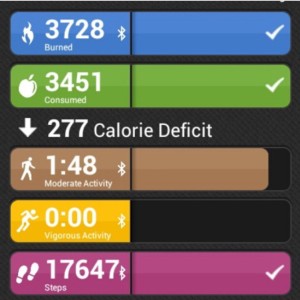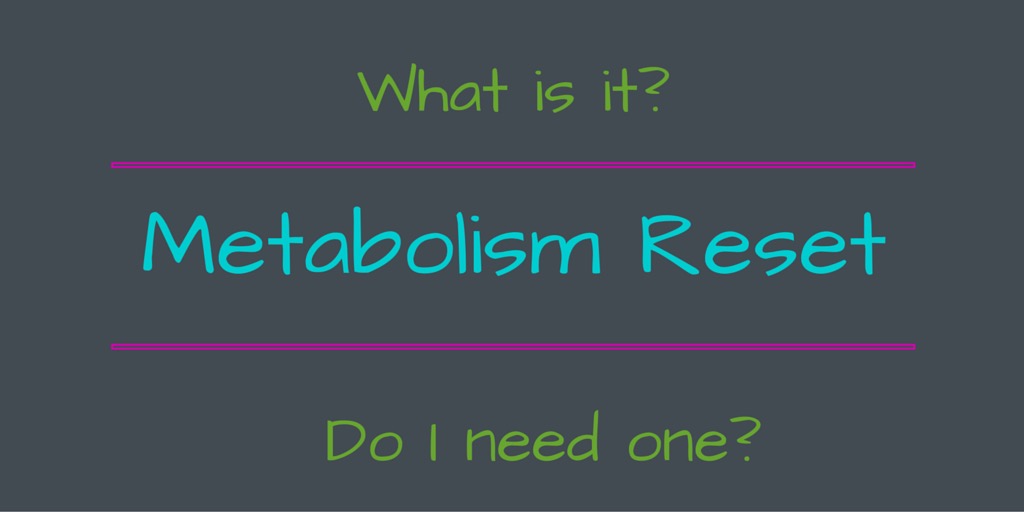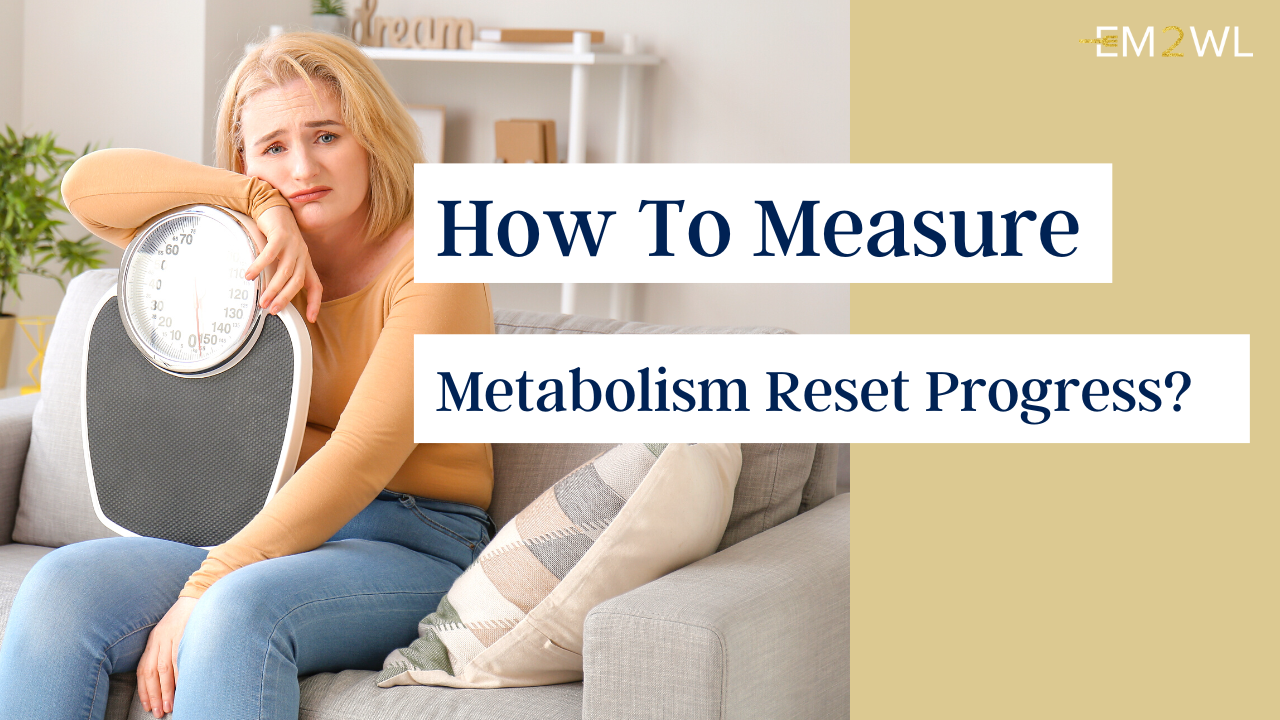Do I Need A Metabolic Reset?
If you are new to this concept of “eating more” and fueling your body properly, you undoubtedly have a lot of questions. You know you should eat  more, but how much? What is a metabolic reset? (And, do I need it?) How long will a reset take? Will this work for me, or am I that “special snowflake” that won’t have success with this? And then thoughts like “I got fat eating more. Why would I want to do that to lose weight?” start running through your mind. It’s enough to make you want to run for the hills!
more, but how much? What is a metabolic reset? (And, do I need it?) How long will a reset take? Will this work for me, or am I that “special snowflake” that won’t have success with this? And then thoughts like “I got fat eating more. Why would I want to do that to lose weight?” start running through your mind. It’s enough to make you want to run for the hills!
Just the idea of increasing calories is a terrifying thought for most people, especially when you have had the “eat less/move more” mentality drilled into your head for your whole life. We get it! We were all there once. Brainwashed by commercials with promises to get you into that skimpy bikini (or Speedo) by summer… The truth of the matter is that these diets will work for a little while, but then the end result is that your weight loss will stall as your metabolism gradually slows down to match the intake. This is the point when most of us start doing some research and realize we have been under-feeding our bodies and need to reverse the tides…
After deciding to take the plunge into the world of Eat More 2 Weigh Less, one of the first questions many people have is: “Do I need to do a metabolic reset?” Well, the answer to this question is as individual as the person asking it.
 ○ Those with a recent history of eating consistently over their TDEE should be able to calculate their TDEE, jump right in at a 15% cut, set their macros at 40/30/30 (40% Carbs, 30% Protein, 30% Fat), and begin the process fairly quickly. These people have been over-eating and have most likely not compromised or slowed their metabolisms in any way, so their bodies should respond quite well to a small deficit. This is the easiest case scenario… No metabolic reset necessary, as they have essentially already done it by previously over-eating!
○ Those with a recent history of eating consistently over their TDEE should be able to calculate their TDEE, jump right in at a 15% cut, set their macros at 40/30/30 (40% Carbs, 30% Protein, 30% Fat), and begin the process fairly quickly. These people have been over-eating and have most likely not compromised or slowed their metabolisms in any way, so their bodies should respond quite well to a small deficit. This is the easiest case scenario… No metabolic reset necessary, as they have essentially already done it by previously over-eating!
○ However… Those who come from long term low calorie dieting, binge/restrict cycles, eating disorders…etc. will have a very different process to go through as their bodies and brains adapt and finally accept the increased caloric intake. Often, years of severe caloric restriction will have resulted in a suppressed metabolism … one which has slowed down to match the decreased intake. When we consistently eat at a caloric deficit, the body will naturally assume that this deficit is now maintenance and downshift the metabolism to meet this demand. If this is your case, a reset is highly recommended.
Potentially, you could go right to that 15% cut in hopes that you would see results, but most likely, you will just be prolonging the process. You see, as you slowly increase your calories to that 15% cut, your body will simply adapt and reset at this 15% cut level, seeing that as the new “normal”. You will have, in fact, reset to your cut value, and therefore, the body will not see it as a cut. From that point, the only real option is to do a true reset, where you eat at TDEE or Maintenance calorie levels for a prolonged period of time (more about this later…) And THEN, once the body has accepted your intake at TDEE as normal, when you introduce that small 15% deficit, the body should react positively by shedding some fat.
SO, if you have been dieting for a prolonged period of time, suffered from an eating disorder or even cycles of binging followed by severe caloric restriction, do yourself a favor and work your intake slowly up to TDEE and take the time to do a metabolic reset. This process will give your body a break from the stress of dieting and allow it to become accustomed to eating proper amounts of food again. If you don’t do it at the onset, most likely you will be doubling back and doing it somewhere further down the road when you don’t see the results you were hoping to see. Skip this vital step, and you will most likely be prolonging the length of your journey rather than speeding it up.
How to Find Your “True” TDEE
So… you have decided that you need to do a metabolic reset in order to get your metabolism back up and running where it should be. Now what?
The first thing that you need to in order to start this process is to determine your TDEE (Total Daily Energy Expenditure). Your TDEE is the amount of calories that your body requires to maintain your weight. That (TDEE) figure includes your BMR (Basal Metabolic Rate) as well as your normal day-to-day activities plus any formal exercise. In theory — based on this definition — if we eat at our TDEE, we will maintain our weight. The problem is that this theory does not always hold true. When we have been under-eating and over-exercising, our body will adapt to this stress. In an attempt to maintain homeostasis, it will down-regulate the metabolism to match the decreased intake. The result will often be a suppressed metabolism. This explains why suddenly you may find yourself gaining weight while doing hours of cardio and eating 1,200 calories or less a day … your body has adapted! You have decreased your intake and increased your exercise for a long enough period of time that the body has finally slowed down your metabolism to match the intake. Your body is doing what it is supposed to do = maintain homeostasis.
To get your metabolism back up and running where it should be, you’ll need to increase your caloric intake back up to TDEE, or do a Metabolic Reset. To begin this process, the first thing you will want to do is enter your stats into the EM2WL weight loss calculator to get your TDEE (maintenance) calories. This will give you an idea of what your ultimate goal will be. But remember that these calculators just give you estimates. They are subject to error based on how much exercise you input into the calculator and how active you truly are. Many newbies to EM2WL lead very active lives, and may actually burn a lot more through their day-to-day activities. If they simply enter in the 4 hours of formal exercise that they do each week, their final TDEE estimate may actually be too low.
Alternatively, you can use an on-body device such as a FitBit, or Apple Watch to get an idea of how much you burn each day. These are likely  more accurate than the calculators, just because they’re monitoring how much activity you actually do each and every day. However, these devices are also not 100% accurate because they don’t accurately calculate calories burned from your strength training workouts.
more accurate than the calculators, just because they’re monitoring how much activity you actually do each and every day. However, these devices are also not 100% accurate because they don’t accurately calculate calories burned from your strength training workouts.
So, where does this leave you? How do you figure out your “true” TDEE? You have your TDEE estimate and/or your “on-body device” average, but ideally you will also test out these numbers and make sure they are truly accurate for you.
The normal process for doing a Metabolic Reset involves increasing your caloric intake up to your calculated TDEE and staying at that level for a minimum of 8 – 12 weeks (much longer if you come from a history of severe dieting or caloric restriction). We generally recommend that you make this increase slowly, adding approximately 50-100 calories to your daily intake each week. Of course, you can certainly jump right up to TDEE quickly (“rip the band-aid”) or make those increases more substantial, but you may find the increases on the scale to be discouraging. By making the increases more gradually, you can often avoid some of the gains seen during the “rip the bandaid” approach. We leave this to the individual as a personal decision.
Now, back to the original question … “How Do I Find My True TDEE?” In order to do this, you will most likely need to go through a trial and error process. You have your calculated TDEE, but how do you figure out if that is “true” or not? As you are going through the process, gradually increasing your daily caloric intake 100 calories a week, keep an eye on the scale. Generally, as you make these increases, you may see the scale jump up a pound or two, and then during the course of the week, it will generally trend back downwards, often ending up right back where you started, pre-increase. As you get closer and closer to your calculated TDEE, you may find that it takes a bit longer for your weight to stabilize and drop back down. At this point, if you find that happening, you may want to take it a bit slower. Then if your weight has not stabilized and dropped back down by the end of the week, wait until it does before making any further increases.
Once you are at or near your calculated TDEE, watch for slow and steady increases on the scale which do not stabilize over time. If you do start seeing gains like this, you have most likely surpassed your TDEE, and which point you can back down on your intake by 100 calories or so and you should be right there — at your true TDEE.
What many people find is that their actual TDEE may be higher than what they get with the calculators. Often their day-to-day activities (chasing kids, doing laundry…etc.) makes them more active than the activity level that they chose when inputting their data into a calculator. We often tend to underestimate how active we are. Many people find that they are actually able to eat 100 or 200 calories more than the calculators give them, simply by “testing the waters” and not blindly accepting those numbers as accurate.
So, give it a try! Surely by now, you have resigned yourself to the fact that this is not a fast process, so take the time to make sure you know your “true TDEE.” Don’t blindly trust the calculators, test it out and see how much you can really eat before you start seeing true gains. Ignore those monthly fluctuations and the jumps that occur after increasing your intake. Keep pushing your intake higher and higher until you start to see slow, steady gains that do not stabilize over time. As hard as it may be, don’t worry about gaining. You can always just drop your intake down and those gains will stop. Remember: nothing that you are doing during this process is irreversible. Take the time to do it right … right from the beginning. You won’t regret it!
When Does My Reset Start?
You have finally gotten brave and decided to do a metabolic reset. You have diligently upped your intake slowly to your calculated TDEE level.
You added 100 calories on each week, and faithfully continued this process until you got your intake from rock bottom all the way up to your maintenance calories, maybe taking months to get to this point. Yay! Now you have reached TDEE, and you are ready to cut, right? NO. Now, this is the point where your metabolic reset actually begins. This is the point where the healing of body and mind starts to take place as your body begins to trust that this new, increased intake will be consistent, and not just another fluctuation, like so many times in the past. Yes, you have just spent what is possibly a few months getting your intake up to maintenance levels, but technically, your reset has not yet begun until now.
Now, you will need to stay eating consistently at TDEE levels for a minimum of 8 – 12 weeks, possibly longer if you come from a long history of severe caloric restriction. Some people have found it takes as long as a year to become fully healed and ready to move on. This part of the journey is as individual as the person taking it. Everybody is different and one size certainly does not fit all. Use this time to introduce strength training into your life, if you haven’t already done so, and enjoy the benefits of building some muscle (which really is possible now that you are finally eating at TDEE). Sit back and truly learn to love eating more.
When Is My Reset Over?
Okay, so you didn’t rush the metabolism reset. You have eaten diligently at maintenance levels for two, three, eight, maybe even twelve months. Congratulations! Now, how do you know when it is over? How do you know when it is the right time to cut?
There are a few key things to look at when making that decision:
○ One thing to consider is the mental aspect of the journey. For many, it is just as important as the physical part. Hopefully, during your reset you have changed the way you view your food. Food is no longer the enemy, and you have begun to see and appreciate it as a much-needed source of fuel. You have learned to no longer fear carbs or fats, and instead fit them in to your daily life (yes, even chocolate!). We feature a lot of Success Stories from EM2WL followers on our website, and hopefully when you read them you have noticed the mental transitions that had to take place both before and during the reset process. This is a vital part of the process. If you have not fully embraced eating more, then you are not ready for a cut.
○ Are you rushing to finish your reset? Are you in a hurry to start that cut? Are you counting down the days until you can introduce that 15% deficit and begin your weight loss journey? If this is you, then you are most likely not ready. At least not mentally…. When your reset is over, you will know it. You will have fully accepted that this is your new way of life. In fact, when you are ready, you will actually be dreading the day you have to give up any calories! Suddenly that 15% deficit will seem huge and you will be contemplating starting with just a 10% cut, or maybe even 8%, or 5… You get the idea :-)
○ As far as the physical aspect, if you have been eating at an extreme deficit prior to beginning your reset and had symptoms of metabolic damage such as fatigue, hair loss, brittle nails, low body temperature and/or loss of menstruation, you should begin to see all of these improving. Seeing improvements in these areas is a good sign that your body is recovering and now using those additional calories for normal maintenance functions, and not simply the vital ones.
 ○ Your weight will have stabilized. Often, the reset process comes with some associated weight gain. Some of that is water, as glycogen stores are refilled. Some of it may come from other sources. When we subject our bodies to severe caloric restriction and excessive cardio, the weight that is lost is not all necessarily fat. The weight that is lost can also be from muscles, tendons, ligaments and even brain tissue! As we begin to re-feed and nourish our bodies properly, the body will begin to rebuild that muscle, tendon, ligament and brain tissue and that will show up as a gain on the scale. Note: this is just another reason to not rely on the scale as your sole method for gauging success. Not all scale losses are good ones! … I mean, who wants to lose brain tissue?!
○ Your weight will have stabilized. Often, the reset process comes with some associated weight gain. Some of that is water, as glycogen stores are refilled. Some of it may come from other sources. When we subject our bodies to severe caloric restriction and excessive cardio, the weight that is lost is not all necessarily fat. The weight that is lost can also be from muscles, tendons, ligaments and even brain tissue! As we begin to re-feed and nourish our bodies properly, the body will begin to rebuild that muscle, tendon, ligament and brain tissue and that will show up as a gain on the scale. Note: this is just another reason to not rely on the scale as your sole method for gauging success. Not all scale losses are good ones! … I mean, who wants to lose brain tissue?!
As you have worked your way through the reset process, chances are, your weight may have fluctuated. A lot. By the time your reset is complete, these fluctuations should have stabilized. Yes, you will still have those ups and downs caused by water retention following a high sodium day, or water retention due to DOMS following a heavy lifting day, or that normal 3 – 5 pound gain many see around TOM, but overall your weight should be holding fairly stable.
○ By the time you are ready to cut, all of those overly full, bloated feelings that you may have experienced as you increased your calories should have subsided. You should feel comfortable eating at your Maintenance calories (TDEE). You should not feel like an over-stuffed turkey on Thanksgiving, in fact you should feel hungry again! These are all signs that your metabolism has returned to a normal state.
No matter what your dieting history, EM2WL will work for you. It is all just a matter of doing your research, figuring out your “numbers” and determining what plan will be correct for you, and then putting that plan in place to get you to your caloric goal. Each person’s plans will be different. Some people will see results in as little as 4 – 6 weeks, while others may take as long as a year, depending on their dieting history (the more severe the dieting history, the longer the “metabolic healing” can be expected to take). Research and patience will be key, in either case. And, if you need help along the way, EM2WL is here to help with our online courses and coaching programs.
Are you curious about how the process works, or wondering what's in our Starter Kit E-Book? START HERE. We'll send you a free breakdown of the basics, exclusive videos explaining why everything that you've learned about diets have only led you astray, and an action plan to take your life back immediately.
No worries, we hate spam too!
Discover more from Eat More 2 Weigh Less
Subscribe to get the latest posts sent to your email.






hi eatmore2weighless community,
i started my reset by november 2016. ever since i have been making progess in the gym in terms of strength gain. i stopped weight lifting/exercises after 3 months because i didnt have enough time.(I work as a sales man and i also school part time). however when my reset was over bloating, cravings, joint pains stopped. i began cutting i lost a few pounds but gained them back and even more. i reset again and the same thing occured. please i need help to how to go about it. does it mean it does not work for me?
HI, so I have been trying to find my maintiance for a while now, and I am having some trouble. I am 18 years old, 5’2, and i weight 135. I know that I gained some muscle while getting my intake up to 2200, because my legs are much stronger and there is visible definition, but I don’t want to keep gaining weight. I exercise for around 2 hours a day now, i do 45min to 1 hour of cardio a day, and then I do lifting, strength workout videos for the rest of the time. I had my calories at 2200, but my weight kept going up. I still felt hungry during the day, and was having trouble sleeping and would always want to sleep in longer and longer. I dropped my calories to 1780 one day, and I had no energy, was very shaky and felt horrible and my weight went up 4 pounds that day. So I put by calories back at 2200. One day I just tried to see how my body would react, so I increased my intake to 2400, and I was losing weight. I dropped about 3-4 pounds within 4 days, and then on the fifth day, I ate the same intake, but even after eating one of my larger meals, I still felt a bit hungry and didn’t feel as full as I did in the days prior. My weight then started going back up again. I thought at that point that maybe I was too high in calories, so I put my intake to 2150-2200 again, and I have gained 3.5 pounds in 7 days. I still feel hungry and just uncomfortable, and I am not sure what to do. Are my calories too high, or am I not eating enough?
Thank you for the help, I appreciate it.
As you start eating towards TDEE, what if there are days that you go over (from eating out at a restaurant, etc)? How regimented do we need to be? Can we bump up the number of workouts to counter any potential weight gain from the additional calories?
Hey Manju,
Going over your TDEE once in a while is perfectly fine, and does not require you to add in more exercise. That’s a part of life. Just like sometimes we are under in cals. It all balances out in the end as long as you are consistent
so I have done this in the past, and I was able to keep my same size clothes and increase my calories to 2200. I am a 18 years old and 5’2 female, and I did it while going on the elliptical and keeping up with cardio. I do a lot of long distance running and cardio. I have a fitbit and my heart rate is an average of 140-150 throughout my workout. I have increased my workouts to be an hour and a half or longer a day, and I have been gaining weight at 2200 calories but I feel hungry. I increased my calories by 100 a couple days ago, and I my weight started dropping. today though, I have started gaining weight again and i still feel hungry. should I try to increase my calories a bit more, like could my body still need more food? Or are my calories too high? thanks for any help, im not sure what to do anymore.
Thanks for this informative post!
I have a question… I come from a past of an ED and restricted my calories for a very long time, last months max 800/900kcal..
and i did a lot of moving (which I already decreased in beginning of this year…)
My question..
In this article you advise to slowly work up to TDE
But… I read here some reply’s where you advise to rapidly start on TDE when coming from an ED.
What do you advise me?
Hi Roos, Good question. I think no matter what it needs to work for you. If you aren’t able to get your cals up to TDEE quickly due to your past history, then take it slowly up instead. There really isn’t a right or wrong answer when it comes to healing, so do what works for you.. Slow and steady, or fast and furious:) I think for some ED backgrounds, ripping the bandaid off and jumping up quickly, makes it less painful to get over the calorie levels. But others find they cant get over the mentality of jumping the cals up really fast, especially if you have been eating so low for so long. Make it work for you, no matter what way you go:) Hope this helps
HI, I just started to do this and increase my calories, and im now at 1500ish and the last few jumps I noticed some weight fluctuations, but they did go back down eventually. But with this one, I have noticed that my weight has been kinda going up and hasn’t dropped to my original weight. I’ve only been at this increase for 2 weeks, do you think that it will go back down eventually? Also, is any bloating normal with calorie increase? I’ve noticed that my stomach is a little bit softer and bigger than normal. Also, I am a creature of habit and I love eating the same healthy foods on a daily. I really haven’t changed what i’ve eaten since I started increasing my calories. If I add calories, I usually don’t change the food unless I HAVE to. Is that bad?? I eat healthy foods, I just don;t usually switch it up that often.
Hi Alexis, The reset process is slow and methodical. Changed happening in just a few weeks are normal as your body is adjusting to the influx in calories it desperately needs. Bloating is 100% normal. The idea of a reset is to HEAL, not to see FAT LOSS. You are better suited to pay attention to how you feel, your energy levels, moods, lifts in the gym, etc. The scale will not be a good indicator during this. The great thing about EM2WL is that you can eat whatever you like, not with a diet plan tells you to. So if you enjoy eating the way you are eating, then continue. Add in the cals by eating more of what you like, not filling them in with stuff you don’t. :)
Okay,I just wanted to make sure that the bloating and weight fluctuation and gain was normal. I have been feeling alot more motivated and love working out even more than I did in the past which I didn’t even think was possible! I do love what I eat everyday, I just never change lol Thanks for the help!
You are welcome! Im glad you have found that you love working out! Finding something you love doing is definitely key!
Hi, I know its been a while, but I had another question that I thought might be good to ask you. I kept up with the reverse diet and kept my same size clothes, gained muscle in my legs and increased my calories to 2200. I am a 18 years old and 5’2 female, and I did it while going on the elliptical and keeping up with cardio. I do a lot of long distance running and cardio. I have a fitbit and my heart rate is an average of 140-150 throughout my workout. I have increased my workouts to be an hour and a half or longer a day, and I have been “gaining” weight (which I think might be some water retention, but I am not sure) at 2200 calories but I feel hungry. I increased my calories by 100 a couple days ago, so I was around 2300 and I my weight started dropping. today though, I have started gaining weight again and i still feel hungry. should I try to increase my calories a bit more, like could my body still need more food? Or are my calories too high? thanks for any help, im not sure what to do anymore.
Sounds like you either need more food, or your need a reduction in exercise. 90 min workouts are pretty long, especially if you are doing it more than 3 times a week.
Hi, so I have been trying to find a good maintinace after working at this for quite some time. I am now sucessfully at 2400 calories, but I am having some trouble with my hunger and weight still. So I have been slowly gaining weight at this intake, and I thought that maybe I was too high, so I dropped my calories down to 2150-2200, and I have gained 3 pounds in a week, I always wake up very bloated with water too, and during the day I feel hungry even after eating. My weight is now around 135, and Im 5’2 and 18 years old. I know that I gained some weight overtime from going from 1500 to where I am now, but a lot has been muscle espically in my legs, I now have a little bit visible definiton of my quads. I workout for 2 hours a day, about 1 hour of cardio, usually the elliptical with a resistance of 6-9 and an incline. I then spend the remainder or the time doing workout videos, strength training with dumbbells etc, being that I have an at home gym. I am not sure if my calories are too high now, or If maybe being that I have increased my activity if it isnt high enough. Thank you for the help, I appreciate it,
You are spending too much time going back and forth on your calories. If you are successfully hitting 2400 and thats your TDEE, then stay there for several weeks. Stop letting the scale dictate whether you are successful. Look at other parameters. Are you full? are you sleeping? Are you feeling good? Are you keeping up with activities? If these are all yeses, then don’t lower your calories.
Consistency is key to a reset. You HAVE to hit your TDEE and stay there for a long while. Jumping back and forth in cals is detrimental to your success.
Feel free to join our FB group to get more information and support from other members. Its a much better place to chat than on a blog post! https://www.facebook.com/groups/1754102281470874/
2 years later, still no reply… to you Jessica. Im guessing you shoud eat it back.
Hey Toby, Jessica’s comment was replied to by Anitra right after she posted. Thanks for checking!
This has been extremely interesting. After averaging around 1400 or so calories a day off and on for around a year, I went back up to my tdee of 1950 or so. I also upped my protein as much as I could, shooting for about 100 grams a day, and continued my strength training 2 times a week. After a week I finally stepped on the scale and … I’m down by a pound. Crazy.
Thanks for all the info on metabolic reset. It has been very helpful! I had
I am 3 months in to increasing calories from 1200 to 2300 (still not maintenance). As I increased daily calorie intake, I have gained weight- which I expected. However, as my weight continues to go up, so does my TDEE. When I first calculated calories needed for maintenance, it was 2200; now it is closer to 2700.
I am continuing to reach for that TDEE, but my question is this: do I continue to raise calories to get to my new TDEE? I am still very early in the process, but when should I expect to catch that number?
I just want to thank you ladies for all the great info! I’m so so glad I found your page(s)… I absolutely did NOT believe the calorie calculators and stayed at 1200 calories for far too long. (should have been 2500 or so!) However, my scale has been lonely for me the last few months–it’s seen very little use since I started lifting heavier and I’ve gone from a size 20 jeans to a 12!! :)
So, thanks again for all you do!!
When you figure out your TDEE, your exercise is already factored into that number, so no, you would not eat back those calories.
For example, when you calculated your TDEE to be 2,500 you entered an exercise level based on the numbers of hours you workout each week (Light, Moderate, Strenuous…etc), so that exercise is already added into that number.
The only time you would want to eat back exercise calories is if you should have an exceptionally high burn day and do something not already factored into your normal exercise routine (like a big weekend hike, or a long bike ride with family), then in that case, feel free to eat a couple hundred calories. No need to stress about the exact number of calories burned, just give yourself a little extra fuel that day…
(Oh, and thank you very much :-)
Great article! if you are eating towards your TDEE (adding calories weekly) and you are doing some level of cardio activity should you eat those calories back?
For example if your DEE is 2500 and you are increasing from 1600 and you burn 300 calories doing some exercise should you eat those calories in addition to your daily calories?